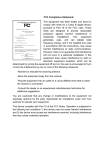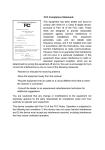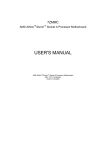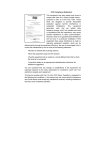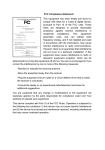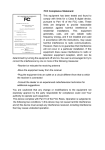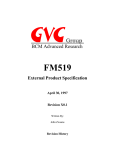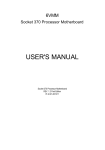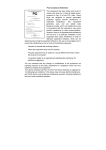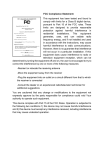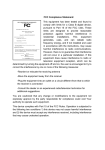Download AMD 7ZX-1 Computer Hardware User Manual
Transcript
7ZX-1 TM AMD Athlon /Duron TM Socket A Motherboard USER'S MANUAL AMD AthlonTM/DuronTM Socket A Processor Motherboard REV. 1.01 First Edition R-101-01-001211 FCC Compliance Statement: DECLARATION OF CONFORMITY Per FCC Part 2 Section 2. 1077(a) Responsible Party Name: G.B.T. INC. Address: 18305 Valley Blvd., Suite#A LA Puent, CA 91744 Phone/Fax No: (818) 854-9338/ (818) 854-9339 hereby declares that the product Product Name: Mother Board Model Number: GA-7ZX Conforms to the following specifications: FCC Part 15, Subpart B, Section 15.107(a) and Section 15.109(a), Class B Digital Device Supplementary Information: This device complies with part 15 of the FCC Rules. Operation is subject to the following two conditions: (1) This device may not cause harmful and (2) this device must accept any inference received, including that may cause undesired operation. Representative Person's Name: Signature: Date: This equipment has been tested and found to comply with limits for a Class B digital device, pursuant to Part 15 of the FCC rules. These limits are designed to provide reasonable protection against harmful interference in residential installations. This equipment generates, uses, and can radiate radio frequency energy, and if not installed and used in accordance with the instructions, may cause harmful interference to radio communications. However, there is no guarantee that interference will not occur in a particular installation. If this equipment does cause interference to radio or television equipment reception, which can be determined by turning the equipment off and on, the user is encouraged to try to correct the interference by one or more of the following measures: ERIC LU Eric Lu -Reorient or relocate the receiving antenna Jun. 30, 2000 -Move the equipment away from the receiver -Plug the equipment into an outlet on a circuit different from that to which the receiver is connected -Consult the dealer or an experienced radio/television technician for additional suggestions You are cautioned that any change or modifications to the equipment not expressly approve by the party responsible for compliance could void Your authority to operate such equipment. This device complies with Part 15 of the FCC Rules. Operation is subjected to the following two conditions 1) this device may not cause harmful interference and 2) this device must accept any interference received, including interference that may cause undesired operation. Declaration of Conformity We, Manufacturer/Importer (full address) G.B.T. Technology Träding GMbH Ausschlager Weg 41, 1F, 20537 Hamburg, Germany declare that the product ( description of the apparatus, system, installation to which it refers) Mother Board GA-7ZX is in conformity with (reference to the specification under which conformity is declared) in accordance with 89/336 EEC-EMC Directive EN 55011 Limits and methods of measurement of radio disturbance characteristics of industrial, scientific and medical (ISM high frequency equipment EN 61000-3-2* EN60555-2 Disturbances in supply systems caused by household appliances and similar electrical equipment “Harmonics” EN55013 Limits and methods of measurement of radio disturbance characteristics of broadcast receivers and associated equipment EN61000-3-3* EN60555-3 Disturbances in supply systems caused by household appliances and similar electrical equipment “Voltage fluctuations” EN 55014 Limits and methods of measurement of radio disturbance characteristics of household electrical appliances, portable tools and similar electrical apparatus EN 50081-1 Generic emission standard Part 1: Residual, commercial and light industry EN 50082-1 Generic immunity standard Part 1: Residual, commercial and light industry EN 55015 Limits and methods of measurement of radio disturbance characteristics of fluorescent lamps and luminaries EN 55081-2 Generic emission standard Part 2: Industrial environment EN 55020 Immunity from radio interference of broadcast receivers and associated equipment EN 55082-2 Generic immunity standard Part 2: Industrial environment EN 55022 Limits and methods of measurement of radio disturbance characteristics of information technology equipment ENV 55104 Immunity requirements for household appliances tools and similar apparatus DIN VDE 0855 part 10 part 12 Cabled distribution systems; Equipment for receiving and/or distribution from sound and television signals EN 50091- 2 EMC requirements for uninterruptible power systems (UPS) CE marking (EC conformity marking) The manufacturer also declares the conformity of above mentioned product with the actual required safety standards in accordance with LVD 73/23 EEC EN 60065 Safety requirements for mains operated electronic and related apparatus for household and similar general use EN 60950 Safety for information technology equipment including electrical business equipment EN 60335 Safety of household and similar electrical appliances EN 50091-1 General and Safety requirements for uninterruptible power systems (UPS) Manufacturer/Importer Signature (Stamp) Date : Jun. 30, 2000 Name : Rex Lin : Rex Lin Table Of Content SUMMARY OF FEATURES................................................................................................................................ 2 7ZX-1 MOTHERBOARD LAYOUT ................................................................................................................... 3 CPU SPEED SETUP ............................................................................................................................................. 4 CONNECTORS..................................................................................................................................................... 5 GAME & AUDIO PORT ......................................................................................................................................... 5 COM A / COM B / LPT PORT ............................................................................................................................ 5 USB 1 CONNECTOR ............................................................................................................................................ 5 USB 2 CONNECTOR ............................................................................................................................................ 6 PS/2 KEYBOARD & PS/2 MOUSE CONNECTOR ................................................................................................... 6 J3: CPU FAN ....................................................................................................................................................... 6 JP6: POWER FAN ................................................................................................................................................. 7 J2: SYSEM FAN .................................................................................................................................................... 7 ATX POWER ........................................................................................................................................................ 7 FLOPPY PORT....................................................................................................................................................... 8 IDE1(PRIMARY), IDE2(SECONDARY) PORT ........................................................................................................ 8 J15: AUX_IN...................................................................................................................................................... 8 J18: CD AUDIO LINE IN ...................................................................................................................................... 9 J13: RING POWER ON (INTERNAL MODEM CARD WAKE UP) .............................................................................. 9 J12: WAKE ON LAN ........................................................................................................................................... 9 JP8 / LED1: STR LED CONNECTOR & DIMM LED........................................................................................ 10 J4: IR ................................................................................................................................................................ 10 PANEL AND JUMPER DEFINITION .............................................................................................................. 11 J11: 2X11 PINS JUMPER ..................................................................................................................................... 11 JP16 /JP17/JP18: AMR (PRIMARY OR SECONDARY) SELECT (OPTIONAL) ........................................................ 11 JP4: REAR USB DEVICE WAKE UP SELECTION (USB CONNECTOR USB1) .................................................. 12 JP7: STR FUNCTION ENABLED (SUSPEND TO RAM) ........................................................................................ 12 JP9: ONBOARD SOUND FUNCTION SELECTION (OPTIONAL) .............................................................................. 12 JP11: FRONT USB DEVICE WAKE UP SELECTION (USB PORT USB2).......................................................... 13 JP10: BIOS WRITE PROTECTION (OPTIONAL)................................................................................................... 13 JP3: CLEAR CMOS FUNCTION (OPTIONAL)...................................................................................................... 13 BAT1: BATTERY ................................................................................................................................................ 14 PERFORMANCE LIST ..................................................................................................................................... 15 BLOCK DIAGRAM............................................................................................................................................ 16 SUSPEND TO RAM INSTALLATION............................................................................................................. 17 A.2 STR FUNCTION INSTALLATION ................................................................................................................... 17 A.3 HOW TO PUT YOUR SYSTEM INTO STR MODE?............................................................................................ 17 A.4 HOW TO RECOVER FROM THE STR SLEEP MODE?........................................................................................ 19 A.5 NOTICES: .................................................................................................................................................... 19 MEMORY INSTALLATION ............................................................................................................................. 20 BIOS SETUP........................................................................................................................................................ 21 ENTERING SETUP ......................................................................................................................................... 21 CONTROL KEYS ............................................................................................................................................ 21 GETTING HELP.............................................................................................................................................. 21 THE MAIN MENU............................................................................................................................................... 22 STANDARD CMOS SETUP ................................................................................................................................. 23 BIOS FEATURES SETUP ..................................................................................................................................... 25 FIGURE 3: BIOS FEATURES SETUP .................................................................................................................... 25 CHIPSET FEATURES SETUP ................................................................................................................................. 26 POWER MANAGEMENT SETUP ........................................................................................................................... 28 i PNP/PCI CONFIGURATIONS ............................................................................................................................... 30 LOAD BIOS DEFAULTS ...................................................................................................................................... 31 LOAD SETUP DEFAULTS ..................................................................................................................................... 32 INTEGRATED PERIPHERALS ................................................................................................................................ 33 HARDWARE MONITOR ....................................................................................................................................... 36 SET SUPERVISOR / USER PASSWORD.................................................................................................................. 37 IDE HDD AUTO DETECTION ........................................................................................................................... 38 SAVE & EXIT SETUP .......................................................................................................................................... 39 EXIT WITHOUT SAVING ..................................................................................................................................... 40 APPENDIX: ACRONYMS................................................................................................................................. 41 ii 7ZX-1 Motherboard Revision History Revision 1.01 Revision Note Initial release of the 7ZX-1 motherboard user’s manual. Date Dec.2000 The author assumes no responsibility for any errors or omissions that may appear in this document nor does the author make a commitment to update the information contained herein. Third-party brands and names are the property of their respective owners. DEC. 11, 2000 TAIPEI, TAIWAN, R.O.C 1 7ZX-1 Motherboard Summary Of Features Form Factor CPU Chipset Clock Generator Memory I/O Control Slots On-Board IDE 30.5 cm x 22.8 cm ATX size form factor, 4 layers PCB. AMD AthlonTM/DuronTM (K7) Socket A Processor 256K/64K L2 cache on die Supports 500MHz ~ 1GHz and faster Apollo KT133 ,consisting of: VT8363 Memory/AGP/PCI Controller(PAC) VT82C686A PCI Super-I/O Integrated Peripheral Controller (PSIPC) ICS 9248-141 or ICW W230H 3 168-pin DIMM sockets Supports PC-100 / PC-133 SDRAM Supports up to 1.5GB DRAM Supports only 3.3V SDRAM DIMM VT82C686A 1 AGP slot supports 4X mode & AGP 2.0 compliant 5 PCI slots supports 33MHz & PCI 2.2 compliant 1 AMR (Audio Modem Riser) slot Supports PIO mode 3, 4, UDMA33/ATA66 IDE & ATAPI CD-ROM 2 IDE bus master (UDMA 33/ ATA 66) IDE ports for up to 4 ATAPI devices 1 floppy port supports 2 FDD with 1.4M bytes 1 parallel ports supports Normal/EPP/ECP mode 2 serial ports (COM A & COM B) 4 USB ports 1 IrDA connector for IR CPU/System fan revolution detect CPU/System temperature detect System voltage detect CPU overheat shutdown detect PS/2 Keyboard interface and PS/2 Mouse interface AC’97 CODEC Line In / Line Out / Mic In / AUX In / CD In / TEL / Game Port Licensed AMI BIOS, 2M bit flash ROM Support Wake-On-LAN (WOL) Support Internal / External Modem Ring On Support USB KB/MS Wake up from S3-S5 Includes 3 fan power connectors Poly fuse for keyboard over-current protection Support STR (Suspend-To-RAM) function On-Board Peripherals Hardware Monitor PS/2 Connector On-Board Sound BIOS Additional Features 2 7ZX-1 Motherboard 7ZX-1 Motherboard Layout JP4 J3 ATX POWER USB1 PS/2 JP6 LPT COM A Socket A CPU FLOPPY COM B JP8 J15 LED1 JP7 IDE2 IDE1 DIMM3 DIMM2 7ZX-1 DIMM1 J18 GAME & AUDIO VT8363 AGP 1 SW1 Clock Generator AD1881 PCI1 PCI2 BAT1 VT82C 686A J13 PCI3 JP3 J12 JP10 PCI4 J2 PCI5 BIOS JP16 AMR USB2 J4 JP17 BZ1 3 J11 JP11 JP9 JP18 7ZX-1 Motherboard CPU Speed Setup The system bus speed is selectable at 100~133MHz. The user can select the system bus speed by DIP switch SW1. Set System Bus Speed zIf your clock generator (in Motherboard) is ICS 9248-141. You can follow the below reference. ICS 9248-141 SW1: (ICS 9248-141) O : ON, X : OFF FSB 95 Ë100 105 110 113 115 117 133 3 X X O O O X O X 1 O X X O X X X X 2 O O O X X X X X 4 O X X X O O X X zIf your clock generator (in Motherboard) is ICW W230H. You can follow the below reference. SW1: (ICW W230H) FSB 95 Ë100 102 104 106 108 110 112 133 W230H 1 O 0 0 X 0 0 0 0 0 O : ON, X : OFF 2 O X 0 X X 0 X 0 X 3 X X 0 X X X 0 0 0 Ë The FSB Speed of the VIA KT133 is 100MHz. 0AMD CPU Heat Sink Installation: Beware: Please check that the heat sink is in good contact with the CPU before you turn on your system. The poor contact will cause over heat, and might cause damage to your processor. 4 4 X X X 0 0 0 0 0 X Connectors Connectors Game & Audio Port Game Port Line Out 1 MIC In Line In COM A / COM B / LPT Port LPT Port COM A COM B USB 1 Connector 1 2 34 5 67 8 Pin No. 1 2 3 4 5 6 7 8 Definition USB V0 USB D0USB D0+ GND USB V1 USB D1USB D1+ GND 5 Connectors USB 2 Connector 2 10 1 9 Pin No. 1 2 3 4 5 6 7 8 9 10 Definition +5V GND USB D2NC USB D2+ USB D3+ NC USB D3GND +5V PS/2 Keyboard & PS/2 Mouse Connector PS/2 Mouse/Keyboard Pin No. Definition 1 Data 5 6 2 NC 3 4 3 GND 4 VCC(+5V) 2 1 5 Clock PS/2 Keyboard 6 NC PS/2 Mouse J3: CPU Fan 1 Pin No. Definition 1 Control 2 +12V 3 SENSE 6 7ZX-1 Motherboard JP6: Power Fan 1 Pin No. Definition 1 Control 2 +12V 3 NC J2: Sysem Fan 1 Pin No. Definition 1 Control 2 +12V 3 SENSE ATX Power 10 20 1 11 Pin No. Definition 3,5,7,13, GND 15-17 1,2,11 3.3V 4,6,19,20 VCC 10 +12V 12 -12V 18 -5V 8 Power Good 9 5V SB stand by+5V 14 PS-ON(Soft On/Off) 7 Connectors Floppy Port Red Line FDD1 IDE1(Primary), IDE2(Secondary) Port Red Line IDE 1 IDE 2 J15: AUX_IN 1 Pin No. 1 2 3 4 Definition AUX-L GND GND AUX-R 8 7ZX-1 Motherboard J18: CD Audio Line In 1 Pin No. 1 2 3 4 Definition CD-L GND GND CD-R J13: Ring Power On (Internal Modem Card Wake Up) 1 Pin No. Definition 1 Signal 2 GND J12: Wake On LAN 1 Pin No. Definition 1 +5V SB 2 GND 3 Signal 9 Connectors JP8 / LED1: STR LED Connector & DIMM LED STR LED Connector External. 1 + DIMM LED J4: IR 1 Pin No. Definition 1 VCC (+5V) 2 NC 3 IR Data Input 4 GND 5 IR Data Output 10 7ZX-1 Motherboard Panel And Jumper Definition J11: 2x11 Pins Jumper GN SPK HD RE 1 1 1 1 P−P−P+ GN (Green Switch) GD (Green LED) HD (IDE Hard Disk Active LED) SPK (Speaker Connector) RE (Reset Switch) P+P−P−(Power LED) PW (Soft Power Connector) GD PW Open: Normal Operation Close: Entering Green Mode Pin 1: LED anode(+) Pin 2: LED cathode(−) Pin 1: LED anode(+) Pin 2: LED cathode(−) Pin 1: VCC(+) Pin 2- Pin 3: NC Pin 4: Data(−) Open: Normal Operation Close: Reset Hardware System Pin 1: LED anode(+) Pin 2: LED cathode(−) Pin 3: LED cathode(−) Open: Normal Operation Close: Power On/Off Not available at the case For external speaker in the case JP16 /JP17/JP18: AMR (Primary or Secondary) Select (Optional) (AMR Audio Modem Riser) 1 1 1 JP17 JP16 JP18 Onboard AC97 AMR (Primary) Onboard AC97+MR (Secondary) (Default) JP16 ON OFF ON JP17 1-2 3-4 1-2 3-4 11 JP18 1-2 3-4 1-2 Panel and Jumper Definition JP4: Rear USB Device Wake up Selection (USB Connector USB1) 1 Pin No. Definition 1-2 Close Normal (Default) 2-3 Close USB Device Wake up USB1 (If you want to use "USB Dev Wakeup From S3-S5" function, you have to set the BIOS setting "USB Dev Wakeup From S3-S5" enabled, and the jumper "JP4" enabled). *(Power on the computer and as soon as memory counting starts, press <Del>. You will enter BIOS Setup. Select the item "POWER MANAGEMENT SETUP", then select "USB Dev Wakeup From S3-S5: Enabled". Remember to save the setting by pressing "ESC" and choose the "SAVE & EXIT SETUP" option.) JP7: STR Function Enabled (Suspend To RAM) 1 Pin No. Open Close Definition Normal (Default) STR Enabled JP9: Onboard Sound Function Selection (Optional) JP9 1 Pin No. Definition 1-2 close Onboard Sound Enable (Default) 2-3 close Onboard Sound Disable 12 7ZX-1 Motherboard JP11: Front USB Device Wake up Selection (USB Port USB2) 1 USB2 Pin No. Definition 1-2 close Normal (Default) Enabled Front USB Device 2-3 close Wake up (If you want to use "USB Dev Wakeup From S3-S5" function, you have to set the BIOS setting "USB Dev Wakeup From S3-S5" enabled, and the jumper "JP11" enabled). *(Power on the computer and as soon as memory counting starts, press <Del>. You will enter BIOS Setup. Select the item "POWER MANAGEMENT SETUP", then select "USB Dev Wakeup From S3-S5: Enabled". Remember to save the setting by pressing "ESC" and choose the "SAVE & EXIT SETUP" option.) JP10: BIOS Write Protection (Optional) 1 Pin No. Definition ON Write Protect Enable Write Protect Disable OFF (Default) Please Set Jumper JP10 to ”OFF” to enabled BIOS Write Function when you update new BIOS or new device JP3: Clear CMOS Function (Optional) 1 Pin No. Definition 1-2 close Normal (Default) 2-3 close Clear CMOS 13 Panel and Jumper Definition BAT1: Battery + CAUTION ☞ Danger of explosion if battery is incorrectly replaced. ☞ Replace only with the same or equivalent type recommended by the manufacturer. ☞ Dispose of used batteries according to the manufacturer’s instructions. 14 Performance List Performance List The following performance data list is the testing results of some popular benchmark testing programs. These data are just referred by users, and there is no responsibility for different testing data values gotten by users. (The different Hardware & Software configuration will result in different benchmark testing results.) • CPU AMD ThunderbirdTM 950MHz, AMD DuronTM 700MHz • DRAM (256x1) MB SDRAM (HYUNDAI HYM71V733201) • CACHE SIZE 256 KB included in Thunderbird 64 KB included in Duron • DISPLAY GA-GF2560 • STORAGE Onboard IDE (Quantum KA13600AT) • O.S. TM Windows NT 4.0 SPK6a Display Driver at 1024 x 768 65536 colors 75Hz. TUCD 1.5 Beta3 • DRIVER AMD Processor ThunderbirdTM 950MHz (100x9.5) AMD DuronTM 700MHz (100x7) Winbench99 CPU mark 99 86.5 61.5 FPU Winmark 99 5210 3840 Business Disk Winmark 99 5410 5440 Hi-End Disk Winmark 99 13600 13200 Business Graphics Winmark 99 481 352 Hi-End Graphics Winmark 99 985 676 Winstone99 Business Winstone 99 47.3 40.3 Hi-End Winstone 99 50.8 41.6 If you wish to maximize the performance of your system, please refer to the detail on P.43 15 7ZX-1 Motherboard Block Diagram 100MHz Socket A AGP 2X/4X System Bus 100MHz VT8363 3.3V SDRAM 100 / 133MHz 66MHz 100 / 133MHz 100 / 133MHz 66MHz 33MHz ICS 9248-141 or ICW W230H 33MHz 5 PCI ATA66 IDE Channels 33MHz 14.318MHz 4 USB Ports 48MHz VT82C 686A Game Port COM Ports LPT Ports IR Floppy AC97 CODEC AMR PS/2 16 Suspend to RAM Installation Suspend To RAM Installation A.1 Introduce STR function: Suspend-to-RAM (STR) is a Windows 98 ACPI sleep mode function. When recovering from STR (S3) sleep mode, the system is able, in just a few seconds, to retrieve the last “state” of the system before it went to sleep and recover to that state. The “state” is stored in memory (RAM) before the system goes to sleep. During STR sleep mode, your system uses only enough energy to maintain critical information and system functions, primarily the system state and the ability to recognize various “wake up” triggers or signals, respectively. A.2 STR function Installation Step 1: (If you want to use STR Function, please set jumper JP7 Closed.) 1 Pin No. Open Close Definition Normal (Default) STR Enabled Step 2: Power on the computer and as soon as memory counting starts, press <Del>. You will enter BIOS Setup. Select the item “POWER MANAGEMENT SETUP”, then select “ACPI Sleep Type : S3 / STR”. Remember to save the settings by pressing "ESC" and choose the “SAVE & EXIT SETUP” option. Congratulation! You have completed the installation and now can use the STR function. A.3 How to put your system into STR mode? 1. There are two ways to accomplish this: Choose the “Stand by” item in the “Shut Down Windows” area. A. Press the “Start” button and then select “Shut Down” 17 Suspend to RAM Installation B. Choose the “Stand by” item and press “OK” 2. Define the system ”power on” button to initiate STR sleep mode: A. Double click “My Computer” and then “Control Panel” B. Double click the “ Power Management” item. 18 7ZX-1 Motherboard C. Select the “Advanced” tab and “Standby” mode in Power Buttons. D. Restart your computer to complete setup. Now when you want to enter STR sleep mode, just momentarily press the “Power on” button. A.4 How to recover from the STR sleep mode? There are five ways to “wake up” the system: 1. 2. 3. 4. 5. Press the “Power On” button. Use the “Resume by Alarm” function. Use the “Modem Ring On” function. Use the “Wake On LAN” function. Use the “USB Device Wake Up” function. A.5 Notices: 1. In order for STR to function properly, several hardware and software requirements must be satisfied: A. Your ATX power supply must comply with the ATX 2.01 specification (provide more than 720 mA 5V Stand-By current). B. Your SDRAM must be PC-100 / PC-133 compliant. 2. Jumper JP8 is provided to connect to the STR LED in your system chassis. [Your chassis may not provide this feature.] The STR LED will be illuminated when your system is in STR sleep mode. STR LED Connector External. 1 + DIMM LED 19 7ZX-1 Motherboard Memory Installation The motherboard has 3 dual inline memory module (DIMM) sockets. The BIOS will automatically detects memory type and size. To install the memory module, just push it vertically into the DIMM Slot .The DIMM module can only fit in one direction due to the two notch. Memory size can vary between sockets. Install memory in any combination table: DIMM DIMM 1 DIMM 2 DIMM 3 168-pin SDRAM DIMM Modules X 1 pcs Supports 16 / 32 / 64 / 128 / 256 / 512 MB X 1 pcs Supports 16 / 32 / 64 / 128 / 256 / 512 MB X 1 pcs Supports 16 / 32 / 64 /128 / 256 / 512 MB Total System Memory (Max 1.5GB) 20 7ZX-1 Motherboard BIOS Setup BIOS Setup is an overview of the BIOS Setup Program. The program that allows users to modify the basic system configuration. This type of information is stored in battery-backed CMOS RAM so that it retains the Setup information when the power is turned off. ENTERING SETUP Power ON the computer and press <Del> immediately will allow you to enter Setup. If the message disappears before you respond and you still wish to enter Setup, restart the system to try again by turning it OFF then ON or pressing the "RESET" bottom on the system case. You may also restart by simultaneously press <Ctrl> − <Alt>− <Del> keys. CONTROL KEYS <↑> <↓> <←> <→> <Esc> <+/PgUp> <-/PgDn> <F1> <F2> <F3> <F4> <F5> <F6> <F7> <F8> <F9> <F10> Move to previous item Move to next item Move to the item in the left hand Move to the item in the right hand Main Menu - Quit and not save changes into CMOS Status Page Setup Menu and Option Page Setup Menu - Exit current page and return to Main Menu Increase the numeric value or make changes Decrease the numeric value or make changes General help, only for Status Page Setup Menu and Option Page Setup Menu Reserved Reserved Reserved Restore the previous CMOS value from CMOS, only for Option Page Setup Menu Load the default CMOS value from BIOS default table, only for Option Page Setup Menu Load the Setup Defaults Reserved Reserved Save all the CMOS changes, only for Main Menu GETTING HELP Main Menu The on-line description of the highlighted setup function is displayed at the bottom of the screen. Status Page Setup Menu / Option Page Setup Menu Press F1 to pop up a small help window that describes the appropriate keys to use and the possible selections for the highlighted item. To exit the Help Window press <Esc>. 21 BIOS Setup The Main Menu Once you enter AMI BIOS CMOS Setup Utility, the Main Menu (Figure 1) will appear on the screen. The Main Menu allows you to select from nine setup functions and two exit choices. Use arrow keys to select among the items and press <Enter> to accept or enter the sub-menu. AMIBIOS SIMPLE SETUP UTILITY-VERSION 1.23 ( C ) 1999 American Megatrends, Inc. All Rights Reserved STANDARD CMOS SETUP INTEGRATED PERIPHERALS BIOS FEATURES SETUP HARDWARE MONITOR SETUP CHIPSET FEATURES SETUP SUPERVISOR PASSWORD POWER MANAGEMENT SETUP USER PASSWORD PNP/PCI CONFIGURATION IDE HDD AUTO DETECTION LOAD BIOS DEFAULTS SAVE & EXIT SETUP LOAD SETUP DEFAULTS EXIT WITHOUT SAVING ESC : Quit ↑↓←→ : Select Item (Shift) F2 : Change Color F5 : Old Values F6 : Load BIOS Defaults F7: Load Setup Defaults F10: Save & Exit Time, Date, Hard Disk Type, … Figure 1: Main Menu • Standard CMOS Setup This setup page includes all the items in standard compatible BIOS. • BIOS Features Setup This setup page includes all the items of AMI special enhanced features. • Chipset Features Setup This setup page includes all the items of chipset special features. • Power Management Setup This setup page includes all the items of Green function features. • PnP/PCI Configurations This setup page includes all the configurations of PCI & PnP ISA resources. • Load BIOS Defaults Bios Defaults indicates the value of the system parameter which the system would be in the safe configuration. • Load Setup Defaults Setup Defaults indicates the value of the system parameter which the system would be in the most appropriate configuration. • Integrated Peripherals This setup page includes all onboard peripherals. • Hardware Monitor Setup This setup page is auto detect fan and temperature status. • Supervisor password Change, set, or disable password. It allows you to limit access to the system and Setup, or just to Setup. 22 7ZX-1 Motherboard • User password Change, set, or disable password. It allows you to limit access to the system. • IDE HDD auto detection Automatically configure hard disk parameters. • Save & Exit Setup Save CMOS value settings to CMOS and exit setup. • Exit Without Saving Abandon all CMOS value changes and exit setup. Standard CMOS Setup The items in Standard CMOS Features Menu (Figure 2) are divided into 9 categories. Each category includes no, one or more than one setup items. Use the arrows to highlight the item and then use the <PgUp> or <PgDn> keys to select the value you want in each item. AMIBIOS SETUP – STANDARD CMOS SETUP ( C ) 1999 American Megatrends, Inc. All Rights Reserved Date (mm/dd/yyyy) : Tue Jan 25, 2000 Time (hh/mm/ss) : 10:36:24 TYPE SIZE CYLS HEAD PRECOMP LANDZ SECTOR MODE Pri Master : Auto Pri Slave : Auto Sec Master : Auto Sec Slave : Auto Floppy Drive A: 1.44 MB 3 ½ Floppy Drive B: Not Installed Boot Sector Virus Protection : Disabled Month: Jan – Dec Day: 01 – 31 Year : 1990– 2099 Base Memory : 640 Kb Other Memory: 384 Kb Extended Memory: 127Mb Total Memory: 128Mb ESC : Exit ↑↓ : Select Item PU/PD/+/– : Modify (Shift)F2 : Color Figure 2: Standard CMOS Setup • Date The date format is <Week> <Month> <Day>, <Year>. Week Month Day Year The week, from Sun to Sat, determined by the BIOS and is display-only The month, Jan. Through Dec. The day, from 1 to 31 (or the maximum allowed in the month) The year, from 1990 through 2099 • Time The times format in <hour> <minute> <second>. The time is calculated base on the 24-hour military-time clock. For example, 1 p.m. is 13:00:00. • Primary Master, Slave / Secondary Master, Slave The category identifies the types of hard disk from drive C to F that has been installed in the computer. There are two types: auto type, and user definable type. User type is user-definable; Auto type which will automatically detect HDD type. Note that the specifications of your drive must match with the drive table. The hard disk will not work properly if you enter improper information for this category. If you select User Type, related information will be asked to enter to the following items. Enter the information directly from the keyboard and press <Enter>. Such information should be provided in the documentation 23 BIOS Setup form your hard disk vendor or the system manufacturer. CYLS. Number of cylinders HEADS number of heads PRECOMP write precomp LANDZONE Landing zone SECTORS number of sectors If a hard disk has not been installed select NONE and press <Enter>. • Floppy Drive A / Drive B The category identifies the types of floppy disk drive A or drive B that has been installed in the computer. None 360K, 5.25 in. 1.2M, 5.25 in. 720K, 3.5 in. 1.44M, 3.5 in. 2.88M, 3.5 in. No floppy drive installed 5.25 inch PC-type standard drive; 360K byte capacity. 5.25 inch AT-type high-density drive; 1.2M byte capacity (3.5 inch when 3 Mode is Enabled). 3.5 inch double-sided drive; 720K byte capacity 3.5 inch double-sided drive; 1.44M byte capacity. 3.5 inch double-sided drive; 2.88M byte capacity. • Boot Sector Virus Protection If it is set to enable, the category will flash on the screen when there is any attempt to write to the boot sector or partition table of the hard disk drive. The system will halt and the following error message will appear in the mean time. You can run anti-virus program to locate the problem. Enabled Disabled Activate automatically when the system boots up causing a warning message to appear when anything attempts to access the boot sector or hard disk partition table No warning message to appear when anything attempts to access the boot sector or hard disk partition table. (Default Value) • Memory The category is display-only which is determined by POST (Power On Self Test) of the BIOS. Base Memory The POST of the BIOS will determine the amount of base (or conventional) memory installed in the system. The value of the base memory is typically 512 K for systems with 512 K memory installed on the motherboard, or 640 K for systems with 640 K or more memory installed on the motherboard. Extended Memory The BIOS determines how much extended memory is present during the POST. This is the amount of memory located above 1 MB in the CPU's memory address map. Other Memory This refers to the memory located in the 640 K to 1024 K address space. This is memory that can be used for different applications. DOS uses this area to load device drivers to keep as much base memory free for application programs. Most use for this area is Shadow RAM 24 7ZX-1 Motherboard BIOS Features Setup AMIBIOS SETUP – BIOS FEATURES SETUP ( C ) 1999 American Megatrends, Inc. All Rights Reserved 1st Boot Device Floppy 2nd Boot Device CDROM 3rd Boot Device IDE-0 S.M.A.R.T. for Hard Disks Disabled BootUp Num-Lock On Floppy Drive Seek Enabled Password Check Setup ESC : Quit ↑↓→ ←: Select Item F1 : Help PU/PD+/-/ : Modify F5 :Old Values (Shift)F2:Color F6 : Load BIOS Defaults F7 : Load SETUP Defaults Figure 3: BIOS Features Setup • 1st / 2nd / 3rd Boot Device Floppy ZIP A: / LS-120 CDROM SCSI NETWORK IDE-0~IDE-3 Disabled USB FDD ATAPI ZIP C: Boot Device by Floppy. Boot Device by ZIP A: / LS-120. Boot Device by CDROM. Boot Device by SCSI. Boot Device by NETWORK. Boot Device by IDE-0~IDE-3. Boot Device by Disabled. Boot Device by USB FDD. Boot Device by ATAPI ZIP C:. • S.M.A.R.T. for Hard Disks Enabled Disabled Enabled S.M.A.R.T. Hard for Disks. Disabled S.M.A.R.T. Hard for Disks. (Default Value) • Boot Up Num-Lock On Off Keypad is number keys. (Default Value) Keypad is arrow keys. • Floppy Drive Seek During POST, BIOS will determine if the floppy disk drive installed is 40 or 80 tracks. 360 type is 40 tracks while 720 , 1.2 and 1.44 are all 80 tracks. Enabled Disabled BIOS searches for floppy disk drive to determine if it is 40 or 80 tracks. Note that BIOS can not tell from 720, 1.2 or 1.44 drive type as they are all 80 tracks. (Default Value) BIOS will not search for the type of floppy disk drive by track number. Note that there will not be any warning message if the drive installed is 360. • Password Check Setup Always Set Password Check to Setup. (Default Value) Set Password Check to Always. 25 BIOS Setup Chipset Features Setup AMIBIOS SETUP – CHIPSET FEATURES SETUP ( C ) 1999 American Megatrends, Inc. All Rights Reserved *********DRAM Timing*** CAS# Drive DRAM Frequency Auto RAS# Drive SDRAM CAS# Latency Auto AGP Mode AGP Comp. Driving Manual AGP Comp. Driving AGP Aperture Size PCI Delay Transaction USB Controller USB Legacy Support USB Port 64 / 60 Emulation BIOS Flash Protection DRAM Drive Strength MD Bus Strength CAS Bus Strength Delay DRAM Read Latch Memory Data Drive SDRAM Command Drive Memory Address Drive 4X Auto DB 64MB Enabled Enabled Disabled Disabled Disabled Auto High High 1.0ns 8 mA 24 mA 24 mA 12 mA 24 mA ESC : Quit ↑↓→ ←: Select Item F1 : Help PU/PD+/-/ : Modify F5 : Old Values (Shift)F2:Color F6 : Load BIOS Defaults F7 : Load SETUP Defaults Figure 4: Chipset Features Setup • DRAM Frequency 100MHz 133MHz Set DRAM Frequency to 100MHz. Set DRAM Frequency to 133MHz. • SDRAM CAS# Latency 2 3 Auto For Fastest SDRAM DIMM module. For Slower SDRAM DIMM module. Detect SDRAM CAS# Latency by SPD. (Default Value) • AGP Mode 4X 1X 2X Set AGP Mode to 4X. (Default Value) Set AGP Mode to 1X. Set AGP Mode to 2X. • AGP Comp. Driving Auto Manual Set AGP Comp. Driving to Auto. (Default Value) Set AGP Comp. Driving to Manual. If AGP Comp. Driving is Manual. Manual AGP Comp. Driving : 00~FF • AGP Aperture Size 4MB 8MB 16MB 32MB 64MB 128MB 256MB Set AGP Aperture Size to 4MB. Set AGP Aperture Size to 8 MB. Set AGP Aperture Size to 16 MB. Set AGP Aperture Size to 32 MB. Set AGP Aperture Size to 64 MB. (Default Value) Set AGP Aperture Size to 128 MB. Set AGP Aperture Size to 256 MB. • PCI Delay Transaction Enabled Disabled Enabled Delay Transaction. (Default Value) Disabled Delay Transaction. 26 7ZX-1 Motherboard • USB Controller Enabled Disabled Enabled USB Controller. (Default Value) Disabled USB Controller. • USB Legacy Support Keyboard/FD D KB/Mouse/F DD Disabled Set USB Legacy Support Keyboard / Floppy. Set USB Legacy Support Keyboard / Mouse /Floppy. Disabled USB Legacy Support Function. (Default Value) • BIOS Flash Protection Enabled Disabled BIOS Flash Write Protection. Normal. (Default Value) • DRAM Drive Strength Auto Manual Set DRAM Drive Strength Auto. (Default Value) Set DRAM Drive Strength Manual. If DRAM Drive Strength is Manual, then you can adjust item below. • MD Bus Strength High Low Set MD Bus Strength High. (Default Value) Set MD Bus Strength Low. • CAS Bus Strength High Low Set CAS Bus Strength High. (Default Value) Set CAS Bus Strength Low. • Delay DRAM Read Latch 1.0ns 1.5ns 0.5ns No delay Set DRAM Read Latch Delay 1.0ns. (Default Value) Set DRAM Read Latch Delay 1.5ns. Set DRAM Read Latch Delay 0.5ns. Set DRAM Read Latch No delay. • Memory Data Drive 6 mA 8 mA Set Memory Data Drive 6 mA. Set Memory Data Drive 8 mA. (Default Value) • SDRAM Command Drive 16 mA 24 mA Set SDRAM Command Drive 16 mA. Set SDRAM Command Drive 24 mA. (Default Value) • Memory Address Drive 16 mA 24 mA Set Memory Address Drive 16 mA. Set Memory Address Drive 24 mA. (Default Value) • CAS# Drive 8 mA 12 mA Set CAS# Drive 8 mA. Set CAS# Drive 12 mA. (Default Value) • RAS# Drive 16 mA 24 mA Set RAS# Drive 16 mA. Set RAS# Drive 24 mA. (Default Value) 27 BIOS Setup Power Management Setup AMIBIOS SETUP – POWER MANAGEMENT SETUP ( C ) 1999 American Megatrends, Inc. All Rights Reserved ACPI Sleep Type USB Dev Wakeup From S3-S5 Suspend Time Out(Minute) Display Activity IRQ3 IRQ4 IRQ5 IRQ7 IRQ9 IRQ10 IRQ11 IRQ13 IRQ14 IRQ15 Soft-Off by Power Button System after AC Back Modem Use IRQ Resume On Ring/LAN PME Event Wake Up Resume On RTC Alarm S1/POS Disabled Disabled Ignore Monitor Monitor Ignore Monitor Ignore Ignore Ignore Ignore RTC Alarm Date RTC Alarm Hour RTC Alarm Minute RTC Alarm Second Every Day 00 00 00 Monitor Ignore Memory ESC : Quit ↑↓→ ←: Select Item F1 : Help PU/PD+/-/ : Modify F5 :Old Values (Shift)F2:Color F6 : Load BIOS Defaults F7 : Load SETUP Defaults Soft-Off 4 Enabled Enabled Disabled Figure 5: Power Management Setup • ACPI Sleep Type S1/POS S3/STR Set ACPI sleep type to S1. (Default Value) Set ACPI sleep type to S3. • USB Dev Wakeup From S3-S5 Enabled Disabled Enabled USB Dev Wakeup From S3-S5. Disabled USB Dev Wakeup From S3-S5. (Default Value) • Suspend Time Out (Minute.) Disabled 1 2 4 8 10 20 30 40 50 60 Disabled Suspend Time Out Function. (Default Value) Enabled Suspend Time Out after 1min. Enabled Suspend Time Out after 2min. Enabled Suspend Time Out after 4min. Enabled Suspend Time Out after 8min. Enabled Suspend Time Out after 10min. Enabled Suspend Time Out after 20min. Enabled Suspend Time Out after 30min. Enabled Suspend Time Out after 40min. Enabled Suspend Time Out after 50min. Enabled Suspend Time Out after 60min. • Display Activity Ignore Monitor Ignore Display Activity. (Default Value) Monitor Display Activity. • IRQ 3~IRQ15 Ignore Monitor Ignore IRQ3 ~IRQ15. Monitor IRQ3~IRQ15. • Soft-off by Power Button Instant-off Delay 4 sec Soft switch ON/OFF for POWER ON/OFF. (Default Value) Soft switch on 4sec for power OFF. 28 7ZX-1 Motherboard • System after AC Back Function Memory Soft-Off Full-On This function depends on computer status. . (Default Value) Set System Soft-Off Status Set System Full-On Status. • Modem USE IRQ 3, 4, (Default Value) 5, 7, N/A • Resume On Ring / LAN Disabled Enabled Disabled Resume On Ring / LAN. Enabled Resume On Ring / LAN. (Default Value) • PME Event Wake Up Disabled Enabled Disabled PME Event Wake Up. Enabled PME Event Wake Up. (Default Value) • Resume On RTC Alarm You can set “Resume On RTC Alarm” item to enabled and key in Data/time to power on system. Disabled Enabled Disable this function. (Default Value) Enable alarm function to POWER ON system. If the “Resume On RTC Alarm” is Enabled. RTC Alarm Date : RTC Alarm Hour: RTC Alarm Minute : RTC Alarm Second : Every Day, 1~31 0~23 0~59 0~59 29 BIOS Setup PnP/PCI Configurations AMIBIOS SETUP – PNP / PCI CONFIGURATION ( C ) 1999 American Megatrends, Inc. All Rights Reserved PnP Aware OS Yes Reset Configuration Data No VGA Boot from AGP Disabled PCI AGP Palette Snoop PnP DMA Channel 0 DMA Channel 1 PnP DMA Channel 3 PnP PnP DMA Channel 5 PnP DMA Channel 6 PnP DMA Channel 7 IRQ 3 PCI/PnP IRQ 4 PCI/PnP IRQ 5 PCI/PnP IRQ 7 PCI/PnP IRQ 9 PCI/PnP IRQ 10 PCI/PnP ESC: Quit ↑↓→ ←: Select Item IRQ 11 PCI/PnP F1 : Help PU/PD+/-/ : Modify IRQ 14 PCI/PnP F5 :Old Values (Shift)F2:Color IRQ 15 PCI/PnP F6 : Load BIOS Defaults F7 : Load SETUP Defaults Figure 6: PnP/PCI Configuration • PnP Aware OS Yes No Enable PNP Aware OS function. (Default Value) Disable PNP Aware OS function. • Reset Configuration Data No Yes Disable this function. (Default Value) Clear PnP information in ESCD & update DMI data. • VGA Boot From AGP PCI Primary Graphics Adapter From AGP. (Default Value) Primary Graphics Adapter From PCI. • PCI/VGA Palette Snoop Enabled Disabled For having Video Card on ISA Bus and VGA Card on PCI Bus. For VGA Card only. (Default Value) • DMA Channel ( 0,1,3,5,6,7 ) ISA/ EISA PnP The resource is used by Legacy ISA device. The resource is used by PnP device. • IRQ ( 3,4,5,7,9,10,11,14,15 ) ISA/ EISA PCI / PnP The resource is used by Legacy ISA device. The resource is used by PCI/ PnP device. 30 7ZX-1 Motherboard Load BIOS Defaults AMIBIOS SIMPLE SETUP UTILITY-VERSION 1.23 ( C ) 1999 American Megatrends, Inc. All Rights Reserved STANDARD CMOS SETUP INTEGRATED PERIPHERALS BIOS FEATURES SETUP HARDWARE MONITOR SETUP CHIPSET FEATURES SETUP SUPERVISOR PASSWORD POWER MANAGEMENT SETUP USER PASSWORD PNP/PCI CONFIGURATION IDE HDD AUTO DETECTION Load BIOS Defaults (Y/N)? N LOAD BIOS DEFAULTS SAVE & EXIT SETUP LOAD SETUP DEFAULTS EXIT WITHOUT SAVING ESC : Quit ↑↓→← : Select Item (Shift) F2 : Change Color F5 : Old Values F6 : Load BIOS Defaults F7: Load Setup Defaults F10: Save & Exit Load BIOS Default except Standard CMOS Setup Figure 7: Load BIOS Defaults • Load BIOS Defaults BIOS defaults contain the most appropriate values of the system parameters that allow minimum system performance. 31 BIOS Setup Load Setup Defaults AMIBIOS SIMPLE SETUP UTILITY-VERSION 1.23 ( C ) 1999 American Megatrends, Inc. All Rights Reserved STANDARD CMOS SETUP INTEGRATED PERIPHERALS BIOS FEATURES SETUP HARDWARE MONITOR SETUP CHIPSET FEATURES SETUP SUPERVISOR PASSWORD POWER MANAGEMENT SETUP USER PASSWORD Load SETUP Defaults (Y/N)? PNP/PCI CONFIGURATION IDE HDD AUTONDETECTION LOAD BIOS DEFAULTS SAVE & EXIT SETUP LOAD SETUP DEFAULTS EXIT WITHOUT SAVING ESC : Quit ↑↓→← : Select Item (Shift) F2 : Change Color F5 : Old Values F6 : Load BIOS Defaults F7: Load Setup Defaults F10: Save & Exit Load Setup Default except Standard CMOS Setup Figure 8: Load Setup Defaults • Load Setup Defaults Selecting this field loads the factory defaults for BIOS and Chipset Features which the system automatically detects. Please use this setting for maximum system performance. 32 7ZX-1 Motherboard Integrated Peripherals AMIBIOS SETUP – INTEGRATED PERIPHERALS ( C ) 1999 American Megatrends, Inc. All Rights Reserved OnBoard Serial Port A Auto Auto OnBoard Serial Port B Normal Serial PortB Mode Duplex Mode N/A Auto OnBoard Parallel Port Parallel Port Mode ECP Parallel Port DMA Auto Parallel Port IRQ Auto AC97 Audio Auto MC97 Modem Auto ♦OnBoard Legacy Audio ♦Sound Blaster ♦SB I/O Base Address ♦SB IRQ Select ♦SB DMA Select ♦MPU-401 ♦MPU-401 I/O Address ♦Game Port(200h-207h) Enabled Disabled 220h-22Fh 5 1 Disabled 330h-333h Enabled ESC: Quit ↑↓→ ←: Select Item F1 : Help PU/PD+/-/ : Modify F5 :Old Values (Shift)F2:Color F6 : Load BIOS Defaults F7 : Load SETUP Defaults Figure 9: Integrated Peripherals This items will be available when ”Serial PortB Mode” is set to IrDA or ASK IR. ♦These eight items will be shown when there are only AC’97 CODEC sound. • On Board Serial Port A Auto BIOS will automatically setup the port A address. (Default Value) Enable on Board Serial port A and address to 3F8. Enable on Board Serial port A and address to 2F8. Enable on Board Serial port A and address to 3E8. Enable on Board Serial port A and address to 2E8. Disable on Board Serial port A. 3F8/COM1 2F8/COM2 3E8/COM3 2E8/COM4 Disabled • On Board Serial Port B Auto BIOS will automatically setup the port B address. (Default Value) Enable on Board Serial port B and address to 3F8. Enable on Board Serial port B and address to 2F8. Enable on Board Serial port B and address to 3E8. Enable on Board Serial port B and address to 2E8. Disable on Board Serial port B. 3F8/COM1 2F8/COM2 3E8/COM3 2E8/COM4 Disabled • Serial Port B Mode Normal IrDA ASK IR Normal operation. (Default Value) Onboard I/O chip supports IRDA Onboard I/O chip supports ASK IR. • Duplex Mode Half Duplex N/A Full Duplex IR Function Duplex Half. Disabled this function. (Default Value) IR Function Duplex Full. • On Board Parallel port 378 278 3BC Auto Disabled Enable On Board LPT port and address to 378. Enable On Board LPT port and address to 278. Enable On Board LPT port and address to 3BC. Set On Board LPT port to Auto. (Default Value) Disable On Board LPT port. 33 BIOS Setup • Parallel Port Mode EPP ECP Normal EPP+EC P Using Parallel port as Enhanced Parallel Port. Using Parallel port as Extended Capabilities Port. (Default Value) Normal Operation. Using Parallel port as Enhanced Parallel Port & Extended Capabilities Port. • Parallel Port DMA Auto 3 1 0 Set Auto to parallel port mode DMA Channel. (Default Value) Set Parallel Port DMA to 3. Set Parallel Port DMA to 1. Set Parallel Port DMA to 0. • Parallel Port IRQ 7 Auto 5 Set Parallel Port IRQ to 7. Set Auto to parallel Port IRQ DMA Channel. (Default Value) Set Parallel Port IRQ to 5. • AC97 Audio Auto Disabled Enabled On Board AC’97 Audio. (Default Value) Disabled On Board AC’97 Audio. • MC97 Modem Auto Disabled Enabled On Board MC’97 Modem. (Default Value) Disabled On Board MC’97 Modem. • OnBoard Legacy Audio Enabled Disabled Enabled OnBoard Legacy Audio. (Default Value) Disabled OnBoard Legacy Audio. • Sound Blaster Enabled Disabled Enabled Sound Blaster. Disabled Sound Blaster. (Default Value) • SB I/O Base Address 220h22Fh 280h28Fh 260h26Fh 240h24Fh Set SB I/O Base Address to 220h-22Fh. (Default Value) Set SB I/O Base Address to 280h-28Fh. Set SB I/O Base Address to 260h-26Fh. Set SB I/O Base Address to 240h-24Fh. • SB IRQ Select IRQ 5 / 7 / 9 / 10. (Default Value: 5 ) • SB DMA Select DMA 0 / 1 / 2/ 3. (Default Value: 1 ) 34 7ZX-1 Motherboard • MPU-401 Enabled Disabled Enabled MPU-401. Disabled MPU-401. (Default Value) Ps. When Force Feedback joystick is used, MPU-401 needs to be Enable. • MPU-401 I/O Address 330h333h 300h303h 310h313h 320h323h Set MPU-401 I/O Address to 330h-333h. (Default Value) Set MPU-401 I/O Address to 300h-303h. Set MPU-401 I/O Address to 310h-313h. Set MPU-401 I/O Address to 320h-323h. • Game Port (200h-207h) Disabled Enabled Disabled Game Port (200h-207h). Enabled Game Port (200h-207h). (Default Value) 35 BIOS Setup Hardware Monitor AMIBIOS SETUP – HARDWARE MONITOR SETUP ( C ) 1999 American Megatrends, Inc. All Rights Reserved ACPI Shut Down Temp. CPU Temperature System Temperature CPU Fan Speed System Fan Speed Vcore Vdd Vcc3 +5.000V +12.000V Disabled 32°C/89°F 32°C/89°F 7123 RPM 0 RPM 1.76 V 3.33 V 3. 27 V 4.97 V 12.18 V ESC: Quit ↑↓→ ←: Select Item F1 : Help PU/PD+/-/ : Modify F5 :Old Values (Shift)F2:Color F6 : Load BIOS Defaults F7 : Load Setup Defaults Figure 10: Hardware Monitor • ACPI Shutdown Temp. (°°C / °F) (This function will be effective only for the operating systems that support ACPI Function.) Disabled 60°C / 140°F 70°C / 158°F 80°C / 176°F 90°C / 194°F • Disabled ACPI Shutdown function. (Default Value) Monitor CPU Temp. at 60°C / 140°F, if Temp. > 60°C / 140°F system will automatically power off. Monitor CPU Temp. at 70°C / 158°F, if Temp. > 70°C / 158°F system will automatically power off. Monitor CPU Temp. at 80°C / 176°F, if Temp. > 80°C / 176°F system will automatically power off. Monitor CPU Temp. at 90°C / 194°F, if Temp. > 90°C / 194°F system will automatically power off. CPU Temperature (°°C / °F) Detect CPU Temperature automatically. • System Temperature (°°C / °F) Detect System Temperature automatically. • CPU Fan Speed Detect CPU Fan speed status automatically. • System Fan Speed Detect System Fan speed status automatically. • Current Voltage (V) Vcore / Vdd / Vcc3 / +5V / +12V Detect system’s voltage status automatically. 36 7ZX-1 Motherboard Set Supervisor / User Password When you select this function, the following message will appear at the center of the screen to assist you in creating a password. AMIBIOS SIMPLE SETUP UTILITY-VERSION 1.23 ( C ) 1999 American Megatrends, Inc. All Rights Reserved STANDARD CMOS SETUP INTEGRATED PERIPHERALS BIOS FEATURES SETUP HARDWARE MONITOR SETUP CHIPSET FEATURES SETUP SUPERVISOR PASSWORD POWER MANAGEMENT SETUP USER PASSWORD PNP/PCI CONFIGURATIONEnter new supervisor IDE HDDpassword: AUTO DETECTION LOAD BIOS DEFAULTS SAVE & EXIT SETUP LOAD SETUP DEFAULTS EXIT WITHOUT SAVING ESC : Quit ↑↓→← : Select Item (Shift) F2 : Change Color F5 : Old Values F6 : Load BIOS Defaults F7: Load Setup Defaults F10: Save & Exit Chang /Set /Disabled Password Figure 11: Password Setting Type the password, up to six characters, and press <Enter>. You will be asked to confirm the password. Type the password again and press <Enter>. You may also press <Esc> to abort the selection and not enter a password. To disable password, just press <Enter> when you are prompted to enter password. A message “PASSWORD DISABLED” will appear to confirm the password being disabled. Once the password is disabled, the system will boot and you can enter Setup freely. The BIOS Setup program allows you to specify two separate passwords: a SUPERVISOR PASSWORD and a USER PASSWORD. When disabled, anyone may access all BIOS Setup program function. When enabled, the Supervisor password is required for entering the BIOS Setup program and having full configuration fields, the User password is required to access only basic items. If you select “System” at “Password Check” in BIOS Features Setup Menu, you will be prompted for the password every time the system is rebooted or any time you try to enter Setup Menu. If you select “Setup” at “Password Check” in BIOS Features Setup Menu, you will be prompted only when you try to enter Setup. 37 BIOS Setup IDE HDD AUTO Detection AMIBIOS SETUP – STANDARD CMOS SETUP ( C ) 1999 American Megatrends, Inc. All Rights Reserved Date (mm/dd/yyyy) : Tue Jan 25, 2000 Time (hh/mm/ss) : 10:36:24 TYPE SIZE CYLS HEAD PRECOMP LANDZ SECTOR MODE Pri Master : Not Installed Pri Slave : Not Installed Sec Master : Not Installed Sec Slave : Not Installed Floppy Drive A: 1.44 MB 3 ½ Floppy Drive B: Not Installed Boot Sector Virus Protection : Disabled Month: Jan – Dec Day: 01 – 31 Year : 1990– 2099 Base Memory : 640 Kb Other Memory: 384 Kb Extended Memory: 31Mb Total Memory: 32Mb ESC : Exit ↑↓ : Select Item PU/PD/+/– : Modify (Shift)F2 : Color Figure 12: IDE HDD Auto Detection Type "Y" will accept the H.D.D. parameter reported by BIOS. Type "N" will keep the old H.D.D. parameter setup. If the hard disk cylinder number is over 1024, then the user can select LBA mode or LARGER mode for DOS partition larger than 528 MB. 38 7ZX-1 Motherboard Save & Exit Setup AMIBIOS SIMPLE SETUP UTILITY-VERSION 1.23 ( C ) 1999 American Megatrends, Inc. All Rights Reserved STANDARD CMOS SETUP INTEGRATED PERIPHERALS BIOS FEATURES SETUP HARDWARE MONITOR SETUP CHIPSET FEATURES SETUP SUPERVISOR PASSWORD POWER MANAGEMENT SETUP USER PASSWORD PNP/PCI CONFIGURATION IDE HDD AUTO DETECTION SAVE to CMOS and EXIT(Y/N)? Y LOAD BIOS DEFAULTS SAVE & EXIT SETUP LOAD SETUP DEFAULTS EXIT WITHOUT SAVING ESC : Quit ↑↓→← : Select Item (Shift) F2 : Change Color F5 : Old Values F6 : Load BIOS Defaults F7: Load Setup Defaults F10: Save & Exit Save Data to CMOS & Exit Setup Figure 13: Save & Exit Setup Type "Y" will quit the Setup Utility and save the user setup value to RTC CMOS. Type "N" will return to Setup Utility. 39 BIOS Setup Exit Without Saving AMIBIOS SIMPLE SETUP UTILITY-VERSION 1.23 ( C ) 1999 American Megatrends, Inc. All Rights Reserved STANDARD CMOS SETUP INTEGRATED PERIPHERALS BIOS FEATURES SETUP HARDWARE MONITOR SETUP CHIPSET FEATURES SETUP SUPERVISOR PASSWORD POWER MANAGEMENT SETUP USER PASSWORD PNP/PCI CONFIGURATION IDE HDD AUTO DETECTION LOAD BIOS DEFAULTS Quit without saving (Y/N) ? N SAVE & EXIT SETUP LOAD SETUP DEFAULTS EXIT WITHOUT SAVING ESC : Quit ↑↓→← : Select Item (Shift) F2 : Change Color F5 : Old Values F6 : Load BIOS Defaults F7: Load Setup Defaults F10: Save & Exit Abandon all Datas & Exit Setup Figure 14: Exit Without Saving Type "Y" will quit the Setup Utility without saving to RTC CMOS. Type "N" will return to Setup Utility. 40 Appendix Appendix: Acronyms Acronyms ACPI POST LAN ECP APM DMA MHz ESCD CPU SMP USB OS ECC IDE SCI LBA EMC BIOS SMI IRQ NIC A.G.P. S.E.C.C. LED EPP CMOS I/O ESD OEM SRAM VID DMI MIDI IOAPIC DIMM DRAM PAC AMR PCI RIMM DRM ISA MTH CRIMM Meaning Advanced Configuration and Power Interface Power-On Self Test Local Area Network Extended Capabilities Port Advanced Power Management Direct Memory Access Megahertz Extended System Configuration Data Central Processing Unit Symmetric Multi-Processing Universal Serial Bus Operating System Error Checking and Correcting Integrated Dual Channel Enhanced Special Circumstance Instructions Logical Block Addressing Electromagnetic Compatibility Basic Input / Output System System Management Interrupt Interrupt Request Network Interface Card Accelerated Graphics Port Single Edge Contact Cartridge Light Emitting Diode Enhanced Parallel Port Complementary Metal Oxide Semiconductor Input / Output Electrostatic Discharge Original Equipment Manufacturer Static Random Access Memory Voltage ID Desktop Management Interface Musical Interface Digital Interface Input Output Advanced Programmable Input Controller Dual Inline Memory Module Dynamic Random Access Memory PCI A.G.P. Controller Audio Modem Riser Peripheral Component Interconnect Rambus in-line Memory Module Dual Retention Mechanism Industry Standard Architecture Memory Translator Hub Continuity RIMM 41














































